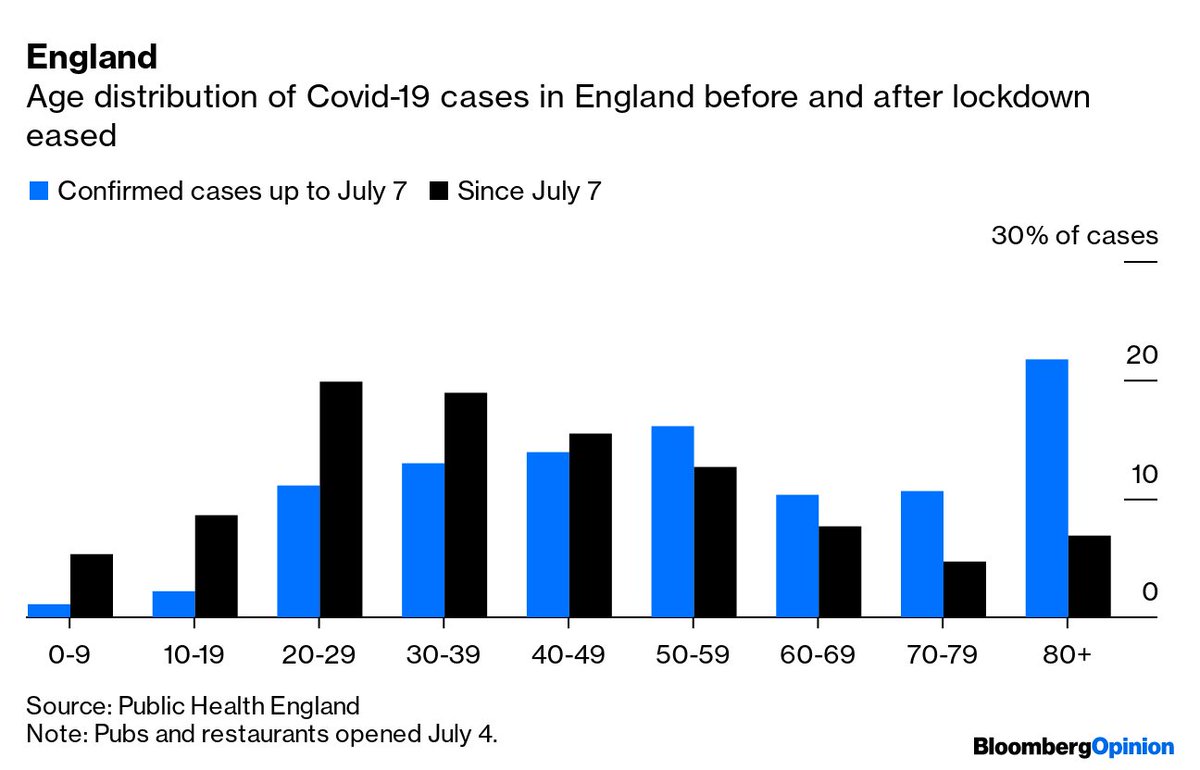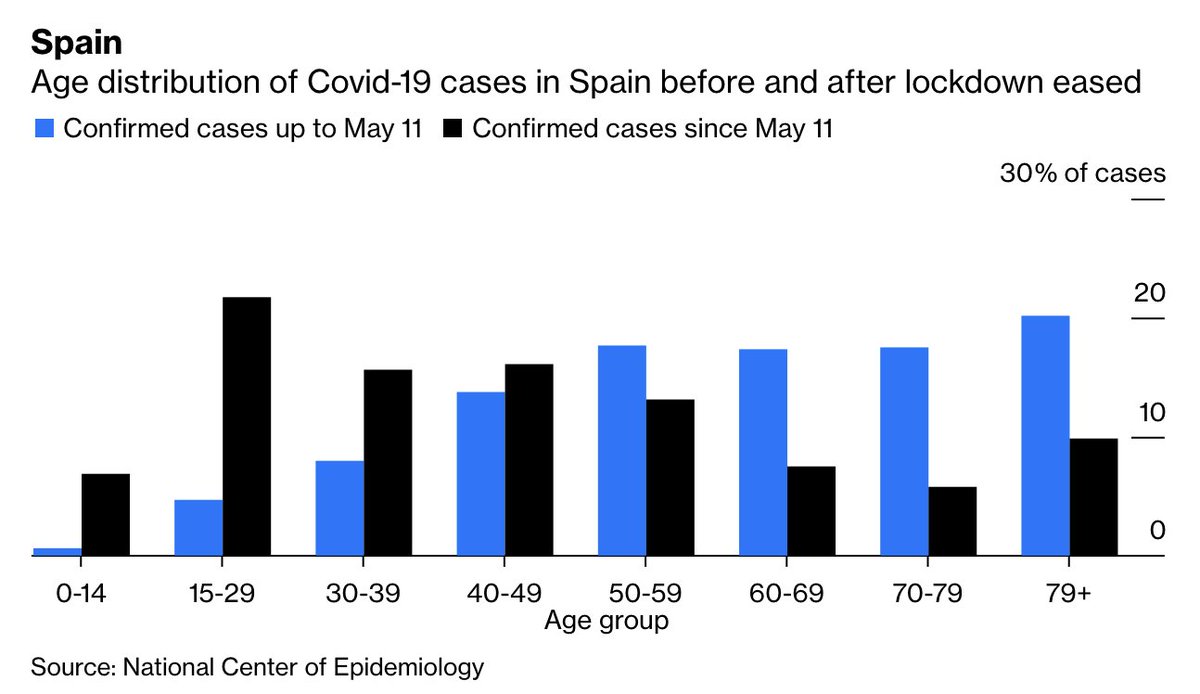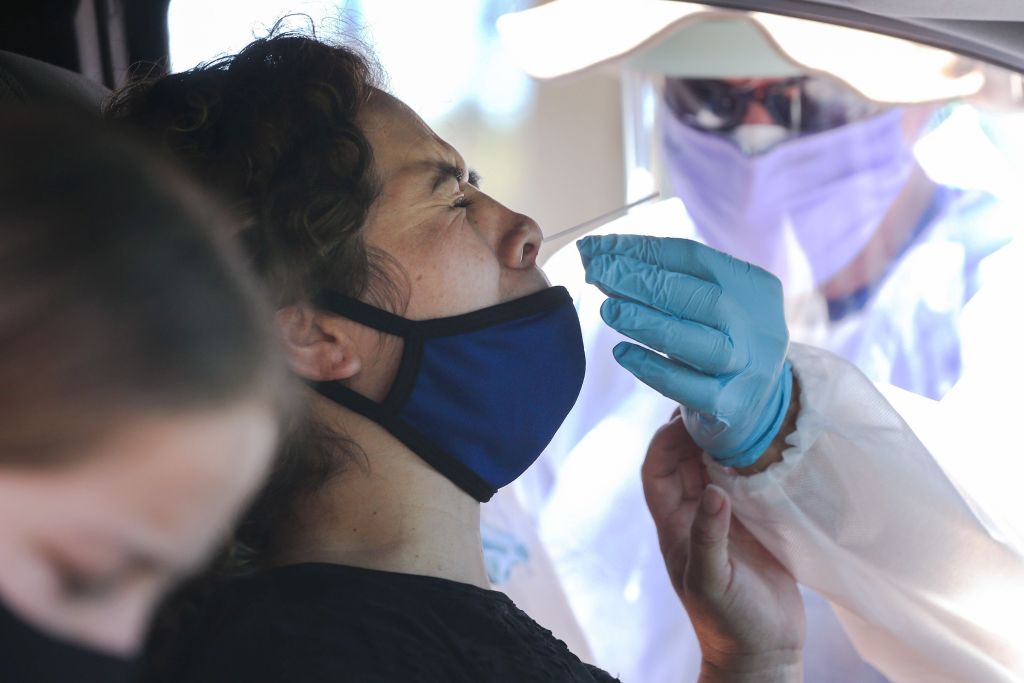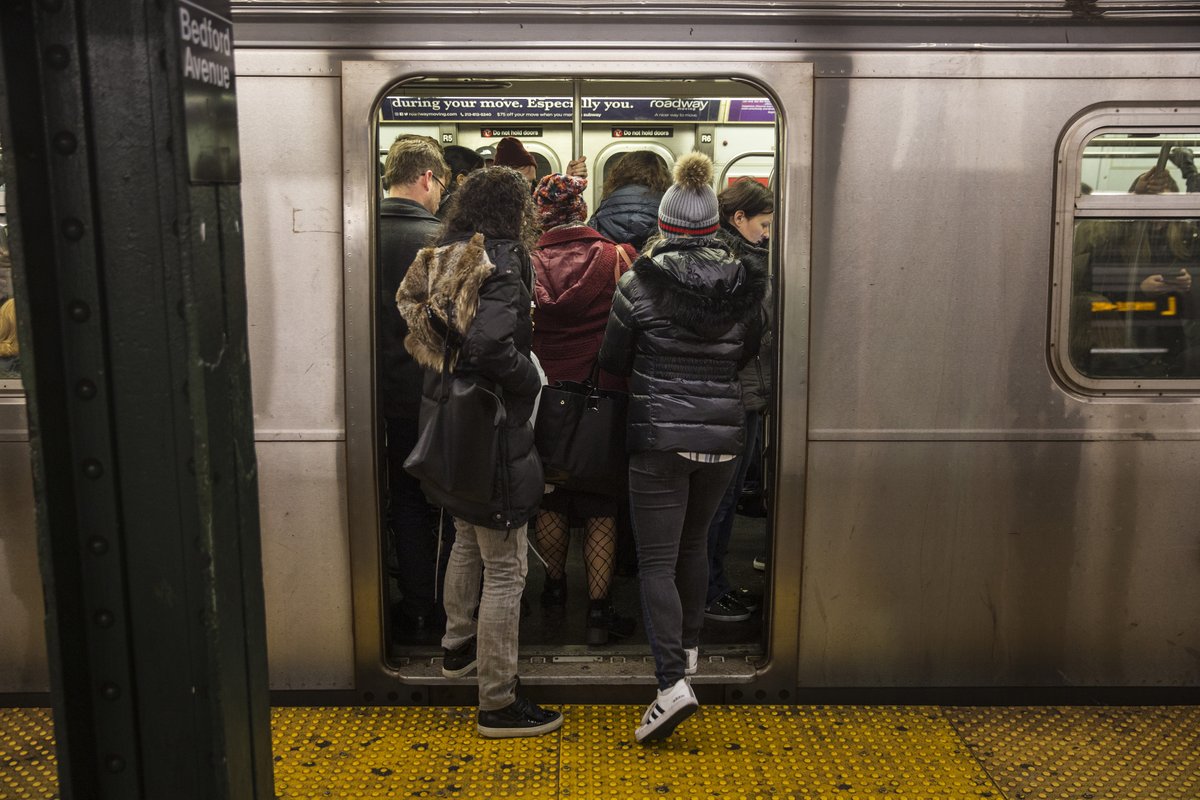In parts of Europe, new coronavirus cases have been creeping up again.
But this time, it’s different: Young people are driving up the virus infection curve https://trib.al/hr7Aq8z ">https://trib.al/hr7Aq8z&q...
But this time, it’s different: Young people are driving up the virus infection curve https://trib.al/hr7Aq8z ">https://trib.al/hr7Aq8z&q...
Early in the crisis, elderly populations accounted for the greatest share of cases.
Now, people aged between 20 and 39 account for about 35% to 40% of new cases in certain countries http://trib.al/hr7Aq8z ">https://trib.al/hr7Aq8z&q...
Now, people aged between 20 and 39 account for about 35% to 40% of new cases in certain countries http://trib.al/hr7Aq8z ">https://trib.al/hr7Aq8z&q...
These charts illustrate that shift, using the date bars and pubs reopened as the dividing line for gauging how things evolved as restrictions were lifted:
 https://abs.twimg.com/emoji/v2/... draggable="false" alt="🏴" title="Flagge von England" aria-label="Emoji: Flagge von England"> ENGLAND:
https://abs.twimg.com/emoji/v2/... draggable="false" alt="🏴" title="Flagge von England" aria-label="Emoji: Flagge von England"> ENGLAND:
 https://abs.twimg.com/emoji/v2/... draggable="false" alt="👩🏻🦱" title="Woman, curly haired (heller Hautton)" aria-label="Emoji: Woman, curly haired (heller Hautton)">20-29: 11.2% of cases pre-easing to 19.8% post-easing
https://abs.twimg.com/emoji/v2/... draggable="false" alt="👩🏻🦱" title="Woman, curly haired (heller Hautton)" aria-label="Emoji: Woman, curly haired (heller Hautton)">20-29: 11.2% of cases pre-easing to 19.8% post-easing
 https://abs.twimg.com/emoji/v2/... draggable="false" alt="👵🏻" title="Ältere Frau (heller Hautton)" aria-label="Emoji: Ältere Frau (heller Hautton)">80+: 21.8% to 6.9% http://trib.al/hr7Aq8z ">https://trib.al/hr7Aq8z&q...
https://abs.twimg.com/emoji/v2/... draggable="false" alt="👵🏻" title="Ältere Frau (heller Hautton)" aria-label="Emoji: Ältere Frau (heller Hautton)">80+: 21.8% to 6.9% http://trib.al/hr7Aq8z ">https://trib.al/hr7Aq8z&q...
Globally, the proportion of 15- to 24-year-olds infected has increased three-fold in the past five months
http://trib.al/hr7Aq8z ">https://trib.al/hr7Aq8z&q...
So what’s going on?
Increased testing could be a factor. At the height of the outbreak, only the very sick -- who tend to be older -- were able to get tested. Now, more widespread testing may just be catching milder or asymptomatic cases in younger people http://trib.al/hr7Aq8z ">https://trib.al/hr7Aq8z&q...
Increased testing could be a factor. At the height of the outbreak, only the very sick -- who tend to be older -- were able to get tested. Now, more widespread testing may just be catching milder or asymptomatic cases in younger people http://trib.al/hr7Aq8z ">https://trib.al/hr7Aq8z&q...
But social-distancing fatigue also plays a role, especially in those younger age groups that don’t feel as at risk.
The WHO has even pleaded with the world’s youth to resist their urge to party http://trib.al/hr7Aq8z ">https://trib.al/hr7Aq8z&q...
The WHO has even pleaded with the world’s youth to resist their urge to party http://trib.al/hr7Aq8z ">https://trib.al/hr7Aq8z&q...
It’s not surprising that young adults are trying to return to a normal life.
During lockdown, many twenty-somethings found themselves living and working in the bedrooms of their cramped, rented accommodation http://trib.al/hr7Aq8z ">https://trib.al/hr7Aq8z&q...
During lockdown, many twenty-somethings found themselves living and working in the bedrooms of their cramped, rented accommodation http://trib.al/hr7Aq8z ">https://trib.al/hr7Aq8z&q...
In Britain, people aged 16 to 24 have only about 26 square meters of liveable room in their homes on average.
Even for those who escaped to the relative comfort of their familial homes, it can still be lonely being separated from peers http://trib.al/hr7Aq8z ">https://trib.al/hr7Aq8z&q...
Even for those who escaped to the relative comfort of their familial homes, it can still be lonely being separated from peers http://trib.al/hr7Aq8z ">https://trib.al/hr7Aq8z&q...
If young people protect themselves from the virus, they’ll also be protecting:
 https://abs.twimg.com/emoji/v2/... draggable="false" alt="👴🏾" title="Älterer Mann (durchschnittlich dunkler Hautton)" aria-label="Emoji: Älterer Mann (durchschnittlich dunkler Hautton)">Older family members
https://abs.twimg.com/emoji/v2/... draggable="false" alt="👴🏾" title="Älterer Mann (durchschnittlich dunkler Hautton)" aria-label="Emoji: Älterer Mann (durchschnittlich dunkler Hautton)">Older family members
 https://abs.twimg.com/emoji/v2/... draggable="false" alt="👩🏾💻" title="Woman technologist (durchschnittlich dunkler Hautton)" aria-label="Emoji: Woman technologist (durchschnittlich dunkler Hautton)">Colleagues
https://abs.twimg.com/emoji/v2/... draggable="false" alt="👩🏾💻" title="Woman technologist (durchschnittlich dunkler Hautton)" aria-label="Emoji: Woman technologist (durchschnittlich dunkler Hautton)">Colleagues
 https://abs.twimg.com/emoji/v2/... draggable="false" alt="🚇" title="U-Bahn" aria-label="Emoji: U-Bahn">Fellow commuters
https://abs.twimg.com/emoji/v2/... draggable="false" alt="🚇" title="U-Bahn" aria-label="Emoji: U-Bahn">Fellow commuters
But how do we get them to do that? http://trib.al/hr7Aq8z ">https://trib.al/hr7Aq8z&q...
But how do we get them to do that? http://trib.al/hr7Aq8z ">https://trib.al/hr7Aq8z&q...
It’s not as simple as asking them to resist the urge to party.
Young urbanites are far more likely to live in shared accommodation. That increases the number of potential transmissions, especially when each housemate has a separate social or work life http://trib.al/hr7Aq8z ">https://trib.al/hr7Aq8z&q...
Young urbanites are far more likely to live in shared accommodation. That increases the number of potential transmissions, especially when each housemate has a separate social or work life http://trib.al/hr7Aq8z ">https://trib.al/hr7Aq8z&q...
Clearer and more consistent messaging could help.
It’s currently not always easy to know what’s permissible and what isn’t at any given time http://trib.al/hr7Aq8z ">https://trib.al/hr7Aq8z&q...
It’s currently not always easy to know what’s permissible and what isn’t at any given time http://trib.al/hr7Aq8z ">https://trib.al/hr7Aq8z&q...
Health officials could also encourage vigilance by sounding the alarm about young Covid patients who& #39;re reporting prolonged, lingering symptoms.
They could go straight to where young people spend much of their time: social media http://trib.al/hr7Aq8z ">https://trib.al/hr7Aq8z&q...
They could go straight to where young people spend much of their time: social media http://trib.al/hr7Aq8z ">https://trib.al/hr7Aq8z&q...
In Preston, a city in the north of England that’s just reentered lockdown, the council leader has urged young people, “Don’t kill granny.”
Done right, such slogans can be a simple but effective way of reminding everyone that we’re in this together http://trib.al/hr7Aq8z ">https://trib.al/hr7Aq8z&q...
Done right, such slogans can be a simple but effective way of reminding everyone that we’re in this together http://trib.al/hr7Aq8z ">https://trib.al/hr7Aq8z&q...

 Read on Twitter
Read on Twitter
 ENGLAND:https://abs.twimg.com/emoji/v2/... draggable="false" alt="👩🏻🦱" title="Woman, curly haired (heller Hautton)" aria-label="Emoji: Woman, curly haired (heller Hautton)">20-29: 11.2% of cases pre-easing to 19.8% post-easinghttps://abs.twimg.com/emoji/v2/... draggable="false" alt="👵🏻" title="Ältere Frau (heller Hautton)" aria-label="Emoji: Ältere Frau (heller Hautton)">80+: 21.8% to 6.9% https://trib.al/hr7Aq8z&q..." title="These charts illustrate that shift, using the date bars and pubs reopened as the dividing line for gauging how things evolved as restrictions were lifted:https://abs.twimg.com/emoji/v2/... draggable="false" alt="🏴" title="Flagge von England" aria-label="Emoji: Flagge von England"> ENGLAND:https://abs.twimg.com/emoji/v2/... draggable="false" alt="👩🏻🦱" title="Woman, curly haired (heller Hautton)" aria-label="Emoji: Woman, curly haired (heller Hautton)">20-29: 11.2% of cases pre-easing to 19.8% post-easinghttps://abs.twimg.com/emoji/v2/... draggable="false" alt="👵🏻" title="Ältere Frau (heller Hautton)" aria-label="Emoji: Ältere Frau (heller Hautton)">80+: 21.8% to 6.9% https://trib.al/hr7Aq8z&q..." class="img-responsive" style="max-width:100%;"/>
ENGLAND:https://abs.twimg.com/emoji/v2/... draggable="false" alt="👩🏻🦱" title="Woman, curly haired (heller Hautton)" aria-label="Emoji: Woman, curly haired (heller Hautton)">20-29: 11.2% of cases pre-easing to 19.8% post-easinghttps://abs.twimg.com/emoji/v2/... draggable="false" alt="👵🏻" title="Ältere Frau (heller Hautton)" aria-label="Emoji: Ältere Frau (heller Hautton)">80+: 21.8% to 6.9% https://trib.al/hr7Aq8z&q..." title="These charts illustrate that shift, using the date bars and pubs reopened as the dividing line for gauging how things evolved as restrictions were lifted:https://abs.twimg.com/emoji/v2/... draggable="false" alt="🏴" title="Flagge von England" aria-label="Emoji: Flagge von England"> ENGLAND:https://abs.twimg.com/emoji/v2/... draggable="false" alt="👩🏻🦱" title="Woman, curly haired (heller Hautton)" aria-label="Emoji: Woman, curly haired (heller Hautton)">20-29: 11.2% of cases pre-easing to 19.8% post-easinghttps://abs.twimg.com/emoji/v2/... draggable="false" alt="👵🏻" title="Ältere Frau (heller Hautton)" aria-label="Emoji: Ältere Frau (heller Hautton)">80+: 21.8% to 6.9% https://trib.al/hr7Aq8z&q..." class="img-responsive" style="max-width:100%;"/>
 BELGIUM:https://abs.twimg.com/emoji/v2/... draggable="false" alt="👨🏿" title="Mann (dunkler Hautton)" aria-label="Emoji: Mann (dunkler Hautton)">20-29: 9.3% to 20.4%https://abs.twimg.com/emoji/v2/... draggable="false" alt="👴🏿" title="Älterer Mann (dunkler Hautton)" aria-label="Emoji: Älterer Mann (dunkler Hautton)">80+: 29.8% to 5.5% https://trib.al/hr7Aq8z&q..." title="https://abs.twimg.com/emoji/v2/... draggable="false" alt="🇧🇪" title="Flagge von Belgien" aria-label="Emoji: Flagge von Belgien"> BELGIUM:https://abs.twimg.com/emoji/v2/... draggable="false" alt="👨🏿" title="Mann (dunkler Hautton)" aria-label="Emoji: Mann (dunkler Hautton)">20-29: 9.3% to 20.4%https://abs.twimg.com/emoji/v2/... draggable="false" alt="👴🏿" title="Älterer Mann (dunkler Hautton)" aria-label="Emoji: Älterer Mann (dunkler Hautton)">80+: 29.8% to 5.5% https://trib.al/hr7Aq8z&q..." class="img-responsive" style="max-width:100%;"/>
BELGIUM:https://abs.twimg.com/emoji/v2/... draggable="false" alt="👨🏿" title="Mann (dunkler Hautton)" aria-label="Emoji: Mann (dunkler Hautton)">20-29: 9.3% to 20.4%https://abs.twimg.com/emoji/v2/... draggable="false" alt="👴🏿" title="Älterer Mann (dunkler Hautton)" aria-label="Emoji: Älterer Mann (dunkler Hautton)">80+: 29.8% to 5.5% https://trib.al/hr7Aq8z&q..." title="https://abs.twimg.com/emoji/v2/... draggable="false" alt="🇧🇪" title="Flagge von Belgien" aria-label="Emoji: Flagge von Belgien"> BELGIUM:https://abs.twimg.com/emoji/v2/... draggable="false" alt="👨🏿" title="Mann (dunkler Hautton)" aria-label="Emoji: Mann (dunkler Hautton)">20-29: 9.3% to 20.4%https://abs.twimg.com/emoji/v2/... draggable="false" alt="👴🏿" title="Älterer Mann (dunkler Hautton)" aria-label="Emoji: Älterer Mann (dunkler Hautton)">80+: 29.8% to 5.5% https://trib.al/hr7Aq8z&q..." class="img-responsive" style="max-width:100%;"/>
 NETHERLANDShttps://abs.twimg.com/emoji/v2/... draggable="false" alt="👱🏼♀️" title="Woman, blond haired (mittelheller Hautton)" aria-label="Emoji: Woman, blond haired (mittelheller Hautton)">20-29: 9.7% to 23.3%https://abs.twimg.com/emoji/v2/... draggable="false" alt="👵🏻" title="Ältere Frau (heller Hautton)" aria-label="Emoji: Ältere Frau (heller Hautton)">80+: 23.2% to 3.8% https://trib.al/hr7Aq8z&q..." title="https://abs.twimg.com/emoji/v2/... draggable="false" alt="🇳🇱" title="Flagge der Niederlande" aria-label="Emoji: Flagge der Niederlande">NETHERLANDShttps://abs.twimg.com/emoji/v2/... draggable="false" alt="👱🏼♀️" title="Woman, blond haired (mittelheller Hautton)" aria-label="Emoji: Woman, blond haired (mittelheller Hautton)">20-29: 9.7% to 23.3%https://abs.twimg.com/emoji/v2/... draggable="false" alt="👵🏻" title="Ältere Frau (heller Hautton)" aria-label="Emoji: Ältere Frau (heller Hautton)">80+: 23.2% to 3.8% https://trib.al/hr7Aq8z&q..." class="img-responsive" style="max-width:100%;"/>
NETHERLANDShttps://abs.twimg.com/emoji/v2/... draggable="false" alt="👱🏼♀️" title="Woman, blond haired (mittelheller Hautton)" aria-label="Emoji: Woman, blond haired (mittelheller Hautton)">20-29: 9.7% to 23.3%https://abs.twimg.com/emoji/v2/... draggable="false" alt="👵🏻" title="Ältere Frau (heller Hautton)" aria-label="Emoji: Ältere Frau (heller Hautton)">80+: 23.2% to 3.8% https://trib.al/hr7Aq8z&q..." title="https://abs.twimg.com/emoji/v2/... draggable="false" alt="🇳🇱" title="Flagge der Niederlande" aria-label="Emoji: Flagge der Niederlande">NETHERLANDShttps://abs.twimg.com/emoji/v2/... draggable="false" alt="👱🏼♀️" title="Woman, blond haired (mittelheller Hautton)" aria-label="Emoji: Woman, blond haired (mittelheller Hautton)">20-29: 9.7% to 23.3%https://abs.twimg.com/emoji/v2/... draggable="false" alt="👵🏻" title="Ältere Frau (heller Hautton)" aria-label="Emoji: Ältere Frau (heller Hautton)">80+: 23.2% to 3.8% https://trib.al/hr7Aq8z&q..." class="img-responsive" style="max-width:100%;"/>
 SPAINhttps://abs.twimg.com/emoji/v2/... draggable="false" alt="👨🏽🦱" title="Man, curly haired (mittlerer Hautton)" aria-label="Emoji: Man, curly haired (mittlerer Hautton)">15-29: 4.7% to 21.8https://abs.twimg.com/emoji/v2/... draggable="false" alt="👴🏾" title="Älterer Mann (durchschnittlich dunkler Hautton)" aria-label="Emoji: Älterer Mann (durchschnittlich dunkler Hautton)">80+: 20.2% to 9.8% https://trib.al/hr7Aq8z&q..." title="https://abs.twimg.com/emoji/v2/... draggable="false" alt="🇪🇸" title="Flagge von Spanien" aria-label="Emoji: Flagge von Spanien"> SPAINhttps://abs.twimg.com/emoji/v2/... draggable="false" alt="👨🏽🦱" title="Man, curly haired (mittlerer Hautton)" aria-label="Emoji: Man, curly haired (mittlerer Hautton)">15-29: 4.7% to 21.8https://abs.twimg.com/emoji/v2/... draggable="false" alt="👴🏾" title="Älterer Mann (durchschnittlich dunkler Hautton)" aria-label="Emoji: Älterer Mann (durchschnittlich dunkler Hautton)">80+: 20.2% to 9.8% https://trib.al/hr7Aq8z&q..." class="img-responsive" style="max-width:100%;"/>
SPAINhttps://abs.twimg.com/emoji/v2/... draggable="false" alt="👨🏽🦱" title="Man, curly haired (mittlerer Hautton)" aria-label="Emoji: Man, curly haired (mittlerer Hautton)">15-29: 4.7% to 21.8https://abs.twimg.com/emoji/v2/... draggable="false" alt="👴🏾" title="Älterer Mann (durchschnittlich dunkler Hautton)" aria-label="Emoji: Älterer Mann (durchschnittlich dunkler Hautton)">80+: 20.2% to 9.8% https://trib.al/hr7Aq8z&q..." title="https://abs.twimg.com/emoji/v2/... draggable="false" alt="🇪🇸" title="Flagge von Spanien" aria-label="Emoji: Flagge von Spanien"> SPAINhttps://abs.twimg.com/emoji/v2/... draggable="false" alt="👨🏽🦱" title="Man, curly haired (mittlerer Hautton)" aria-label="Emoji: Man, curly haired (mittlerer Hautton)">15-29: 4.7% to 21.8https://abs.twimg.com/emoji/v2/... draggable="false" alt="👴🏾" title="Älterer Mann (durchschnittlich dunkler Hautton)" aria-label="Emoji: Älterer Mann (durchschnittlich dunkler Hautton)">80+: 20.2% to 9.8% https://trib.al/hr7Aq8z&q..." class="img-responsive" style="max-width:100%;"/>
 Germany’s age breakdown early in the crisis wasn’t so skewed toward the elderly. But even it& #39;s seeing a similar trend. Globally, the proportion of 15- to 24-year-olds infected has increased three-fold in the past five months https://trib.al/hr7Aq8z&q..." title="https://abs.twimg.com/emoji/v2/... draggable="false" alt="🇩🇪" title="Flagge von Deutschland" aria-label="Emoji: Flagge von Deutschland"> Germany’s age breakdown early in the crisis wasn’t so skewed toward the elderly. But even it& #39;s seeing a similar trend. Globally, the proportion of 15- to 24-year-olds infected has increased three-fold in the past five months https://trib.al/hr7Aq8z&q..." class="img-responsive" style="max-width:100%;"/>
Germany’s age breakdown early in the crisis wasn’t so skewed toward the elderly. But even it& #39;s seeing a similar trend. Globally, the proportion of 15- to 24-year-olds infected has increased three-fold in the past five months https://trib.al/hr7Aq8z&q..." title="https://abs.twimg.com/emoji/v2/... draggable="false" alt="🇩🇪" title="Flagge von Deutschland" aria-label="Emoji: Flagge von Deutschland"> Germany’s age breakdown early in the crisis wasn’t so skewed toward the elderly. But even it& #39;s seeing a similar trend. Globally, the proportion of 15- to 24-year-olds infected has increased three-fold in the past five months https://trib.al/hr7Aq8z&q..." class="img-responsive" style="max-width:100%;"/>




 Older family membershttps://abs.twimg.com/emoji/v2/... draggable="false" alt="👩🏾💻" title="Woman technologist (durchschnittlich dunkler Hautton)" aria-label="Emoji: Woman technologist (durchschnittlich dunkler Hautton)">Colleagueshttps://abs.twimg.com/emoji/v2/... draggable="false" alt="🚇" title="U-Bahn" aria-label="Emoji: U-Bahn">Fellow commutersBut how do we get them to do that? https://trib.al/hr7Aq8z&q..." title="If young people protect themselves from the virus, they’ll also be protecting:https://abs.twimg.com/emoji/v2/... draggable="false" alt="👴🏾" title="Älterer Mann (durchschnittlich dunkler Hautton)" aria-label="Emoji: Älterer Mann (durchschnittlich dunkler Hautton)">Older family membershttps://abs.twimg.com/emoji/v2/... draggable="false" alt="👩🏾💻" title="Woman technologist (durchschnittlich dunkler Hautton)" aria-label="Emoji: Woman technologist (durchschnittlich dunkler Hautton)">Colleagueshttps://abs.twimg.com/emoji/v2/... draggable="false" alt="🚇" title="U-Bahn" aria-label="Emoji: U-Bahn">Fellow commutersBut how do we get them to do that? https://trib.al/hr7Aq8z&q..." class="img-responsive" style="max-width:100%;"/>
Older family membershttps://abs.twimg.com/emoji/v2/... draggable="false" alt="👩🏾💻" title="Woman technologist (durchschnittlich dunkler Hautton)" aria-label="Emoji: Woman technologist (durchschnittlich dunkler Hautton)">Colleagueshttps://abs.twimg.com/emoji/v2/... draggable="false" alt="🚇" title="U-Bahn" aria-label="Emoji: U-Bahn">Fellow commutersBut how do we get them to do that? https://trib.al/hr7Aq8z&q..." title="If young people protect themselves from the virus, they’ll also be protecting:https://abs.twimg.com/emoji/v2/... draggable="false" alt="👴🏾" title="Älterer Mann (durchschnittlich dunkler Hautton)" aria-label="Emoji: Älterer Mann (durchschnittlich dunkler Hautton)">Older family membershttps://abs.twimg.com/emoji/v2/... draggable="false" alt="👩🏾💻" title="Woman technologist (durchschnittlich dunkler Hautton)" aria-label="Emoji: Woman technologist (durchschnittlich dunkler Hautton)">Colleagueshttps://abs.twimg.com/emoji/v2/... draggable="false" alt="🚇" title="U-Bahn" aria-label="Emoji: U-Bahn">Fellow commutersBut how do we get them to do that? https://trib.al/hr7Aq8z&q..." class="img-responsive" style="max-width:100%;"/>






